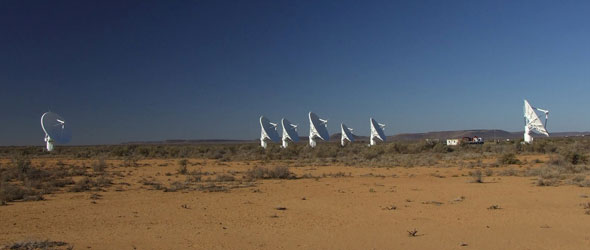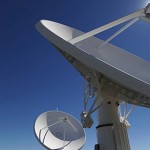South Africa’s KAT-7 telescope – a seven-dish array which is a precursor to the much larger MeerKAT telescope and a prototype for the Square Kilometre Array (SKA) – has reached another milestone by producing the first atomic hydrogen spectral line images of a nearby galaxy.
Southafrica.info reports that astronomers working on the KAT-7 outside the small town of Carnarvon in the Northern Cape pointed the telescope towards a galaxy called NGC 3109 – a small spiral galaxy, about 4.3 million light years away from Earth, located in the constellation of Hydra.
“The observation allowed them to see the HI [neutral hydrogen gas] radio emission of this galaxy, as well as to see how this galaxy is moving,” the SKA South Africa project office said in a statement.
“Where the gas is moving towards us, the frequency of the spectral line is Doppler-shifted upwards; where the gas is moving away, the frequency is shifted down. In this way, astronomers can map the way in which all of the gas in the galaxy is moving.”
SKA South Africa director Dr Bernie Fanaroff said the KAT-7’s latest results “have given us confidence that we know how to build a cutting-edge radio telescope in Africa to answer some of the fundamental questions in radio astronomy.
“Our team in the SKA South Africa project and universities has again shown that they can deliver cutting-edge technology and do excellent science on a very tight schedule,” Fanaroff said in the statement.
South Africa, allied with eight other African countries, is competing against Australia to host the 1.5-billion euro Square Kilometre Array, an instrument 50 to 100 times more sensitive and 10 000 times faster than any radio imaging telescope yet built.
The international science funding agencies and governments involved in the international SKA consortium are due to make an announcement – possibly on the final winning bid – on 4 April, with construction likely to start in 2016 and take place in phases over several years, with completion by about 2022.
South Africa is currently building a 64-dish precursor instrument for the SKA, the Karoo Array Telescope (also known as the MeerKAT) which, regardless of whether South Africa wins the SKA bid, will be a powerful scientific instrument in its own right – as will Australia’s SKA precursor, the 36-dish Pathfinder, which is currently under construction.
According the Fanaroff, a large proportion of the science planned for the SKA – and the MeerKAT – involves mapping the universe using neutral hydrogen.
“Because of the on-going expansion of the universe, distant galaxies are moving away from us,” Fanaroff said.
“Measuring the frequency of the spectral line from neutral hydrogen in those galaxies allows us to work out how far away they are. By finding billions of distant galaxies, astronomers will be able to map the structure of the universe and how it has changed over time.
“This ‘cosmic census’ of the neutral hydrogen in galaxies – far and near – is essential in understanding the deeper physics of the universe, by answering fundamental questions such as the nature of dark matter and dark energy.
“Observations of the neutral hydrogen content of galaxies also help to form a picture of how galaxies have evolved over cosmic time and show how our own galaxy, the spiral galaxy called the Milky Way, has developed.”
The radio waves which the KAT-7 picked up from galaxy NGC 3109 were processed in a correlator, a first stage of computing that currently allows gas velocity to be measured to an accuracy of 10km/s.
Further upgrades to the KAT-7’s computing system, due to be made during the course of this year, will enable astronomers to study this galaxy with a velocity resolution of 1km/s.
Professor Claude Carignan, South African SKA research chair in multi-wavelength astronomy at the University of Cape Town, explained: “Such a high velocity resolution will allow us to distinguish between the conventional models, which suppose the presence of an important quantity of dark matter (matter that cannot be seen but that is detected by its gravitational influence) and the Modified Newtonian Dynamics (MOND) models, which suppose that no dark matter is present but that it is instead the laws of gravity that change on galaxy scales.
“We also speculate that an unusual warp in the disk of this galaxy could be caused by a tidal interaction with its dwarf companion galaxy, known as Antlia,” Carignan said. “Future KAT-7 observations should reveal more information on this possible interaction.”
Bradley Frank, a PhD student at UCT and lead researcher for the HI imaging of nearby galaxies with KAT-7, said it was “particularly exciting that we will soon be able to derive new scientific results with a relatively small precursor array”.
The spiral galaxy NGC 3109 was discovered by the English scientist John Herschel on 24 March 1835 while he was doing astronomical research in South Africa. – BuaNews







